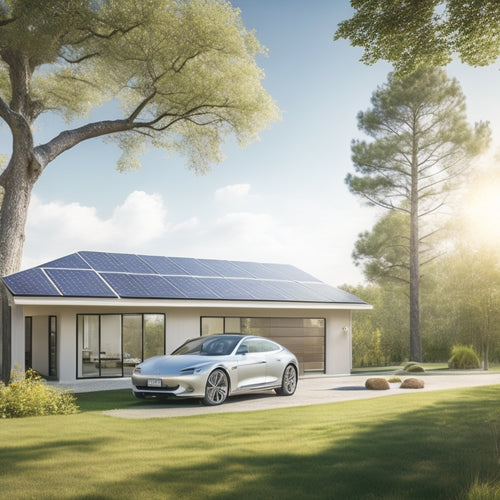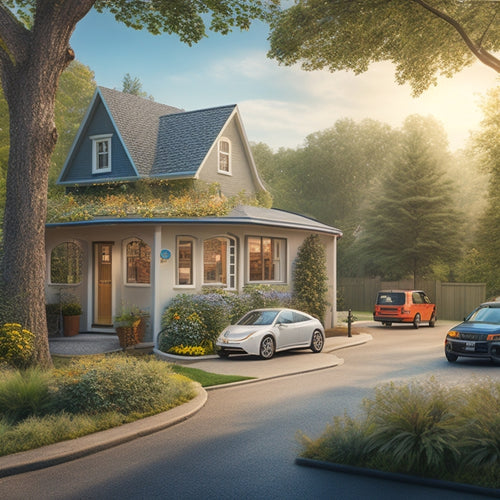
Installing Solar Panels in Your Backyard in 10 Easy Steps
Share
You're taking a significant step towards reducing your carbon footprint and saving on energy bills by deciding to install solar panels in your backyard. To get started, assess your energy needs by evaluating past utility bills and identifying peak hours of energy usage. Choose a location with maximum solar exposure, select a solar panel system that fits your needs and budget, and prepare your roof structure for installation. Obtain necessary permits, hire a licensed installer, and install mounting hardware. Connect your solar panels together, hook up to the electrical grid, and start monitoring your system's performance. Now, take the next step to turning your backyard into a renewable energy hub.
Key Takeaways
- Assess energy needs by evaluating past utility bills to determine the required system capacity for partial or off-grid energy goals.
- Choose a location with maximum solar exposure, conducting a shading analysis to ensure optimal panel performance and minimal obstructions.
- Select a solar panel system based on efficiency, durability, and warranty, considering monocrystalline, polycrystalline, and thin-film options.
- Ensure the roof structure is suitable for solar panels, assessing its age, condition, and load-bearing capacity, and making necessary modifications.
- Obtain necessary permits, researching local regulations and zoning laws, and hiring a licensed installer with NABCEP certification and a proven track record.
Assess Your Energy Needs
Before you start planning your solar panel installation, evaluate your energy needs to determine how much electricity you need to generate. This step is vital in ensuring you get the right system size for your property. Review your past utility bills to understand your energy consumption patterns. Identify the peak hours of energy usage and the total amount of kilowatt-hours (kWh) consumed per month. This information will help you determine the required system capacity.
Additionally, consider your energy goals. Do you want to cover a portion of your energy needs or go completely off-grid? Knowing your energy requirements will also help you take advantage of available solar incentives.
For instance, the federal solar investment tax credit (ITC) allows you to claim a credit of 26% of the total system cost. By accurately evaluating your energy needs, you'll be able to optimize your solar panel installation, reduce your energy bills, and maximize your return on investment.
Choose the Right Location
Most residential solar panels are installed on rooftops, which makes choosing the right location a significant step in the installation process.
You'll want to identify the area that receives the most solar exposure throughout the day. This is essential since solar panels rely on sunlight to generate energy.
To determine the ideal location, you'll need to conduct a shading analysis. This involves evaluating any obstructions that might cast a shadow on your solar panels, such as:
- Trees or branches that could block sunlight
- Neighboring buildings or structures that could cast a shadow
- Vent pipes, skylights, or chimneys that could obstruct sunlight
Select a Solar Panel System
With numerous solar panel systems available, you need to select one that suits your energy requirements and budget.
You'll want to evaluate the type of solar panels, system efficiency, and overall performance. There are three main solar panel types: monocrystalline, polycrystalline, and thin-film. Monocrystalline panels are the most efficient but also the most expensive. Polycrystalline panels are a popular choice, offering a good balance between efficiency and cost. Thin-film panels are the least expensive but also the least efficient.
When assessing system efficiency, look for the percentage of sunlight converted into electricity. Higher-efficiency systems produce more power per hour of sunlight.
You'll also want to evaluate the system's durability, warranty, and maintenance requirements. Assess your energy needs and determine the required system size. A larger system may not always be the best choice, as it may not be fully deployed.
Research and compare different systems to find the one that best meets your needs and budget. By selecting the right solar panel system, you'll be well on your way to tapping into the power of the sun and reducing your energy bills.
Prepare Your Roof Structure
You'll need to assess your roof's age and condition to determine if it's suitable for solar panels.
Next, you'll conduct a structural integrity check to guarantee your roof can support the added weight of the panels.
Roof Age and Condition
Before installing solar panels, assess your roof's age and condition to confirm it can support the additional weight and withstand the elements for years to come.
A roof's lifespan plays a significant role in determining its suitability for solar panels. Typically, a roof should have at least 10-15 years of life remaining to confirm a worthwhile investment.
Consider the following factors when evaluating your roof's condition:
-
Visible signs of wear: Look for cracked, curled, or missing shingles, which can indicate a weakened roof structure.
-
Past repairs and maintenance: Check if your roof has undergone recent repairs or replacements, which can affect its overall integrity.
-
Age-related deterioration: Consider the natural aging process, which can cause roofs to become more prone to leaks and damage over time.
Structural Integrity Check
Your roof's structural integrity is critical to supporting the weight of solar panels, and a thorough inspection is crucial to identify any weaknesses or potential issues. You'll need to determine if your roof's load bearing capacity can handle the added weight of the solar panels, mounting system, and other equipment.
| Inspection Area | What to Check For |
|---|---|
| Roof Framing | Signs of rot, cracks, or damage to beams and rafters |
| Roof Decking | Loose, missing, or damaged decking boards |
| Flashing | Loose, damaged, or corroded flashing around chimneys, vents, and skylights |
| Gutters and Downspouts | Clogged, sagging, or damaged gutters and downspouts |
| Roof-to-Wall Connections | Loose or corroded connections between the roof and walls |
If you identify any weaknesses or issues, you may need to make structural modifications to guarantee your roof can support the solar panels. This could include reinforcing the roof framing, replacing roof decking, or repairing flashing and gutters. It's vital to address these issues before proceeding with the installation to guarantee a safe and successful project.
Supportive Beams and Rafters
As you prepare your roof structure for solar panel installation, it's vital to focus on the supportive beams and rafters, which form the backbone of your roof's structure.
These components guarantee the roof can withstand various loads, including the weight of the solar panels, wind, and snow.
To guarantee a sturdy roof, you'll need to assess the following aspects of your supportive beams and rafters:
-
Beam types: Check if you have solid beams, engineered wood products, or laminated veneer lumber (LVL). Each type has its load-bearing capacity, so it's important to identify the ones you have.
-
Rafter spacing: Verify the distance between your rafters, as it affects the structural integrity of your roof. Typical rafter spacing ranges from 16 to 24 inches on-center.
-
Condition and damage: Inspect your beams and rafters for signs of rot, cracks, or pest damage, which can compromise their strength and stability.
Obtain Necessary Permits
Several permits are required before you can start installing your solar panels.
You'll need to comply with local regulations, zoning laws, and building codes to guarantee your system meets safety and environmental standards. Begin by submitting permit applications to your local government, which will review your plans and inspect your property to confirm code compliance.
You may also need to obtain approval from your homeowner association, if you have one.
Be prepared to provide detailed plans and specifications of your solar panel system, including its size, location, and potential environmental impact. Meeting inspection requirements is essential, as it will determine whether your system is installed correctly and safely.
Plan ahead, as the permit process can take several weeks to a few months, depending on the complexity of your application and the workload of your local authorities.
Factor this into your installation timelines to avoid delays. By obtaining the necessary permits, you'll guarantee a smooth and successful solar panel installation that meets all the required standards.
Hire a Licensed Installer
Get set to bring in a professional by hiring a licensed installer who can guarantee your solar panel system is installed correctly and efficiently.
This vital step assures that your investment pays off in the long run. A licensed installer brings the necessary knowledge and experience to the table, guaranteeing a seamless installation process.
When searching for an installer, look for the following qualifications:
- NABCEP (North American Board of Certified Energy Practitioners) certification, which is the gold standard in the industry
- A proven track record of successful installations and happy customers
- A clear understanding of local building codes and regulations
Install Mounting Hardware
With your licensed installer on board, you're ready to begin the installation process. Now it's time to install the mounting hardware, an essential step in securing your solar panels.
Your installer will determine the best mounting techniques and hardware types for your specific roof and solar panel system. They'll assess your roof's structure, considering factors like size, material, and pitch, to select the appropriate mounting hardware.
You'll need to choose between roof-mounted, ground-mounted, or tracking systems. Roof-mounted systems are the most common, while ground-mounted systems are ideal for larger systems or those with limited roof space. Tracking systems, which adjust to the sun's movement, are perfect for maximum energy production.
Your installer will guarantee the mounting hardware is durable, weather-resistant, and compliant with local building codes.
Next, your installer will prepare the roof or ground surface, cleaning and inspecting it for any damage or obstacles. They'll then install the mounting hardware, carefully securing it to the roof or ground to withstand environmental elements and support the weight of your solar panels.
Connect Solar Panels Together
You've reached the stage where your solar panel system starts taking shape. Now it's time to connect the individual panels together to form a cohesive unit. This step requires attention to detail and a solid understanding of electrical connections.
You'll need to decide between series connections and parallel connections. Here's what you need to know:
-
Series connections: Panels are connected end-to-end, increasing the voltage while keeping the current constant. This configuration is ideal for systems with limited space.
-
Parallel connections: Panels are connected side-by-side, increasing the current while keeping the voltage constant. This setup is better suited for systems with varying panel sizes or orientations.
-
Be mindful of the connectors and cables, verifying they're compatible with your system's voltage and current ratings.
Remember to follow the manufacturer's instructions and local electrical codes to guarantee a safe and efficient connection. Proper connections will maximize your system's energy output and prevent potential hazards.
Hook Up to Electrical Grid
You'll now need to connect your solar panel system to the electrical grid, a process that requires careful planning and execution.
The grid connection process involves installing a specialized inverter that synchronizes your system's output with the grid's frequency and voltage.
Grid Connection Process
Installing solar panels on your property means generating clean energy, but it's only half the battle - the other half is feeding that energy back into the grid. This is where the grid connection process comes in. In order to successfully connect your solar panel system to the grid, you'll need to meet specific grid connection requirements, which vary depending on your location and utility company.
-
Your solar panel system must be designed to match the grid's electrical frequency and voltage.
-
You'll need to install a grid-tie inverter, which converts the DC power from your solar panels into AC power that's compatible with the grid.
-
Your system must be equipped with safety features, such as ground fault protection and arc fault detection, to prevent electrical shocks and fires.
When choosing a solar inverter, you'll have several types to evaluate, including string inverters, microinverters, and power optimizers. Each has its own advantages and disadvantages, so it's crucial to select the one that best fits your system's design and your energy needs.
Net Metering Benefits
Once you've successfully connected your solar panel system to the grid, the benefits of net metering kick in, allowing you to offset your energy consumption with the excess energy your system produces. This means you'll only pay for the energy you use from the grid, minus the energy you've produced and fed back into it.
As a result, you'll see significant cost savings on your utility bills, which can add up to thousands of dollars over the lifespan of your solar panel system.
Moreover, net metering allows you to make a positive environmental impact by reducing your reliance on fossil fuels and lowering your carbon footprint. By producing clean, renewable energy, you're contributing to a cleaner, healthier environment for yourself and your community.
Plus, with net metering, you can track your energy production and consumption in real-time, giving you a sense of control and ownership over your energy usage.
Monitor and Maintain System
Your solar panel system is generating clean energy, and now it's vital to monitor and maintain it to guarantee ideal performance and longevity.
You've invested in a system that will provide you with years of renewable energy, but it's important to keep an eye on its performance to make sure you're getting the most out of it.
Regular monitoring helps you identify any potential issues before they become major problems.
You'll be able to:
- Track your system's energy production in real-time, comparing it to your energy consumption
- Receive alerts and notifications if there are any malfunctions or drops in system performance
- Schedule routine inspections and maintenance to prevent minor issues from escalating
Frequently Asked Questions
Can I Install Solar Panels on a Rented Property?
You'll need to review your rental agreements and understand your tenant rights before installing solar panels on a rented property, as you'll likely require your landlord's permission and may need to negotiate terms that benefit both parties.
Are There Any Solar Panel Systems for Small Budgets?
You're shining a light on affordability! Yes, you can utilize solar power without breaking the bank. Look for affordable options like DIY kits, used or refurbished panels, and energy-efficient systems that cater to budget considerations, making solar energy a realistic dream for you.
Do Solar Panels Work During Power Outages?
You're wondering if solar panels work during power outages? Well, with solar energy storage and off-grid systems, you can capture electricity even when the grid goes down, ensuring continuous power supply and independence from the grid.
Will Solar Panels Affect My Roof's Warranty?
You'll want to check your roof warranty before installing solar panels, as the installation process may void or modify the warranty; understanding roof warranty implications and solar panel installation risks will help you make an informed decision that suits your needs.
Can I Sell Excess Energy Back to the Grid?
You're generating clean energy like a pro, and now you're wondering if you can sell the excess back to the grid. With net metering benefits, you can do just that, earning energy credit options and offsetting your utility bills, making you a renewable energy rockstar!
Conclusion
You've finally reached the finish line! Installing solar panels in your backyard is a bright idea that's paid off. Now, you're cooking with gas - utilizing free energy from the sun to power your home. With these 10 easy steps, you've taken a significant step towards reducing your carbon footprint and saving on energy bills. Pat yourself on the back, and get ready to bask in the savings!
Related Posts
-

Why Invest in Solar Car Battery Chargers Online?
By investing in a solar car battery charger online, you're not only reducing your reliance on fossil fuels but also o...
-

Why Nearby EV Conversion Shops Matter to You
Having a nearby EV conversion shop means you'll experience the benefits of a more personalized, convenient, and susta...
-

What You Need to Know About RV Solar Maintenance
When you're out on the road, your RV's solar panel system is your lifeline. But without regular maintenance, you're l...


